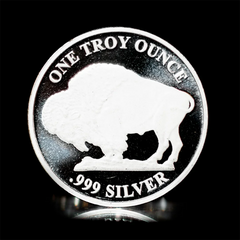Key Takeaways
-
Silver Offers A Dual Advantage: Silver’s role as both a precious metal and an industrial commodity makes it uniquely positioned to benefit from economic uncertainty and global manufacturing demand.
-
Volatility Comes With Upside: While silver prices can fluctuate, the metal has shown long-term resilience and offers meaningful growth potential as part of a diversified investment strategy.
-
Silver vs. Gold: If you're focused on affordability and long-term upside, silver may offer more flexibility. Gold, by contrast, is often preferred for wealth preservation.
Should You Be Investing In Silver Right Now?
With market volatility rising and inflation concerns lingering, many investors are taking a closer look at tangible assets, especially silver. But with its dual identity as both a precious metal and an industrial commodity, it’s fair to ask: Is silver a good investment in today’s climate?
At Summit Metals, we believe that silver’s dual identity as both a monetary metal and an industrial resource continues to shape investor demand. It offers an accessible way to exchange dollars for real value, especially for those looking to build a long-term position size or complement existing gold holdings. In this article, we’ll break down historical trends, the current case for silver, and how to evaluate if it fits your investment strategy.
Historical Trends In Silver Prices
Silver has served as a monetary asset and industrial resource for centuries, but its modern price movements are closely tied to economic cycles, inflation trends, and global market shifts. Recognizing these patterns is essential for investors evaluating whether silver still holds long-term value.
Major Price Surges And Economic Context
Silver’s most dramatic historical price spike occurred in 1980, when it surged to nearly $50 per ounce amid inflation fears and the Hunt brothers’ infamous attempt to corner the market. While the spike was short-lived, it underscored how silver responds to economic uncertainty and monetary instability.
Another significant rally occurred in 2011. At this time, silver approached $50 per ounce during the aftermath of the 2008 financial crisis, widespread central bank stimulus, and rising inflation concerns.
In both cases, silver’s price growth was driven by investor demand for real, tangible assets—evidence of its role as a safe haven during volatile times.
Silver’s Resilience Through Market Cycles
While silver is known for its volatility, it has also demonstrated remarkable staying power when other asset classes faltered. In times of stock market downturns, currency devaluation, or inflation, silver has historically held its ground or outperformed. This resilience is supported not only by investor demand but by silver’s indispensable role in high-demand sectors such as electronics, solar energy, and medical technology. Silver’s utility-based demand gives it a dual foundation, making it a valuable hedge that also participates in economic growth cycles.
Why Silver Is More Volatile Than Gold
Compared to gold, silver experiences more frequent and sharper price movements. This volatility stems from its smaller market size, greater dependence on industrial demand, and sensitivity to shifts in manufacturing and supply chains. While this can create short-term fluctuations, it also presents buying opportunities for long-term investors looking to exchange currency for hard assets at strategic price points.
The Long-Term Trajectory: Steady Growth With Cycles
Despite temporary corrections, the long-term trend in silver pricing has shown a gradual upward movement, particularly when viewed across multi-decade timeframes. Those who take a patient approach have often benefited from silver’s ability to act as both a store of value and a source of growth, especially during periods of monetary uncertainty or dollar weakness.
Historical Patterns Still Matter Today
Understanding silver’s historical performance helps investors recognize recurring conditions that tend to favor silver ownership: inflation, geopolitical instability, and weakening currencies. While no market trend is guaranteed to repeat, history shows that silver consistently proves its worth when the broader economic outlook is uncertain.
An Overview Of The Current Silver Market
Silver remains one of the most dynamic assets in the precious metals space, offering a unique combination of monetary security and industrial utility. This dual identity distinguishes silver from other assets. At Summit Metals, we encourage investors to look beyond short-term trends and examine the fundamental forces shaping silver’s price trajectory.
Demand: A Precious Metal With Industrial Utility
Unlike gold, which is primarily used for wealth preservation and jewelry, silver plays a critical role in global industries. It’s essential in the production of solar panels, electronics, medical equipment, and automotive components, especially in the push toward renewable technologies. As governments and companies worldwide move toward sustainable infrastructure, demand for silver is expected to remain strong.
Yet silver doesn’t lose its status as a hedge. Silver retains its appeal as a store of value in times of inflation, currency devaluation, or global financial instability. This rare combination of industrial and monetary demand helps explain its enduring role in well-balanced investment portfolios.
Supply: Dependent On Broader Mining Trends
Silver is often produced as a byproduct of mining for other metals, such as copper, lead, and zinc. This makes its supply chain more complex. Changes in the mining output of these base metals can impact silver availability, regardless of direct demand. In some cases, supply bottlenecks or geopolitical developments in major mining countries may lead to short-term volatility or price spikes.
At Summit Metals, we follow these patterns closely to help investors make informed decisions based on broader supply conditions, not just headline prices.
Macroeconomic Uncertainty And Investor Sentiment
Today’s economic environment—marked by persistent inflation, rising interest rates, and geopolitical tension—pushes investors toward tangible, inflation-resistant assets. Silver has benefited from this trend, attracting both new and seasoned investors looking for protection and potential upside. While silver can be more volatile than gold in the short term, it also presents greater opportunity for growth, particularly when industrial demand rises in tandem with investor appetite.
The Bottom Line
A complex mix of global economic trends, industrial demand, mining dynamics, and investor sentiment influences the silver market. Understanding how these elements interact is key to making informed decisions. For investors evaluating silver today, it’s not just about timing the market; it’s about recognizing the real-world forces that give silver its long-term strategic value. Summit Metals is here to provide verified silver products, real-time pricing, and transparent insight, so you can invest with confidence.
Silver vs. Gold: Which Is The Better Investment?
While gold often dominates the conversation around precious metals, silver plays a distinct and valuable role for investors seeking both diversification and growth. The question isn’t which metal is “better,” but which one fits your goals, risk tolerance, and strategy. Here’s how they compare:
-
Volatility vs. Stability: Gold is known for price stability, especially during economic stress. Silver, by contrast, tends to be more volatile. However, that volatility can present upside potential during bull markets, making it attractive to investors with a higher risk appetite.
-
Affordability and Accessibility: Silver’s lower price point makes it easier to enter the market or add to positions over time. It allows investors to exchange currency for tangible assets at smaller increments, which can be especially practical for new buyers who are gradually building a position.
-
Industrial Demand: Silver is widely used in electronics, solar energy, and medical applications. This industrial demand can drive strong price momentum, but it also increases sensitivity to broader economic trends, contributing to its volatility.
-
Supply And Liquidity: Gold is one of the most liquid assets in the world, traded at high volumes and held in central bank reserves. Silver is also highly liquid, but the market is smaller, and certain products may have wider bid-ask spreads, especially in lower-mintage coins. You can also sell both to us at Summit Metals!
-
Portfolio Diversification: Gold offers defense and wealth preservation. Silver adds growth potential and utility-based demand. Together, they provide balance, helping investors weather uncertainty while maintaining exposure to long-term value.
Choosing between silver and gold isn’t about declaring a clear winner. At Summit Metals, we view them as complementary tools in a well-built portfolio. For many investors, a balanced allocation to both metals offers the best of both worlds: gold’s stability plus silver’s upside potential.
How To Start Investing In Silver
Investing in silver is a way to exchange paper currency for lasting, tangible value in an uncertain world. The good news is that getting started with silver is straightforward, especially when you focus on purpose, product, and protection. The first step is determining what you're aiming to achieve. Are you looking to hedge against inflation, diversify your portfolio, or hold an accessible asset outside traditional banking systems? Knowing your intent will shape the right silver investment strategy.
Choose The Right Type Of Silver
Once you’ve defined your goals, consider the form that best fits your plan. Silver bars and rounds usually come with lower premiums and are ideal for building weight efficiently. Government-issued silver coins—like the American Silver Eagle or Canadian Silver Maple Leaf—carry slightly higher premiums but offer recognized purity, liquidity, and added peace of mind.
Work With A Trusted Seller
Where you buy your silver matters. A trustworthy dealer provides clear, real-time pricing, not inflated markups or delayed quotes. They offer investment-grade products from recognized mints, and every item is accompanied by documentation verifying its purity and authenticity.
At Summit Metals, all of our silver is independently tested through X-ray and electromagnetic analysis before being shipped or vaulted. We don’t just sell silver; we verify it, price it transparently, and stand behind it. That’s what sets a real dealer apart from the rest.
Decide On A Secure Storage Method
After your purchase, storage becomes a critical part of your strategy. Some investors choose to store silver at home in a high-security, fireproof safe. Others prefer professional storage for greater peace of mind. Summit Metals offers insured, segregated depository services, complete with 24/7 security, real-time tracking, and on-demand delivery. This way, we give you full ownership and flexibility over your assets.
Stay Informed And In Control
Silver isn’t a set-it-and-forget-it asset. When you invest in a precious metal, you want to make sure your position continues to serve your long-term goals. That means more than just watching the spot price. Track how much silver you own, what you paid for it, and how market conditions are shifting over time. If inflation rises, currencies weaken, or industrial demand spikes, you’ll want to understand how those forces impact silver’s value, not after the fact, but while there’s still time to act. Staying informed puts you in control, helping you make adjustments based on strategy, not emotion. It’s not about timing the market perfectly; it’s about making smart, timely decisions that keep your silver working for you.
Final Thoughts
Silver continues to stand out as a compelling option for investors seeking both value and versatility. Its unique role as an industrial metal and a store of wealth gives it the potential to perform in a range of economic conditions, from inflationary pressure to industrial expansion. While it may come with more price movement than gold, that volatility often brings opportunity. Overall, silver continues to offer a meaningful way to exchange cash for something real, especially for investors focused on long-term value, not short-term speculation.
Read also:
Frequently Asked Questions About Whether Silver Is Still A Good Investment
How does silver perform during market downturns?
Silver has historically held value well when equities decline or inflation rises. While more volatile than gold, it often draws investor interest during periods of uncertainty due to its affordability and track record as a real asset.
What are the signs of a silver market bubble?
Rapid price increases driven by speculation, rather than industrial demand or long-term investment fundamentals, can signal a bubble. Spikes in media attention and retail interest from non-investors are common red flags. Staying focused on value, not momentum, is key.
How liquid is the silver market if I need to sell quickly?
Silver is widely traded and generally liquid. Standard bars and coins can often be sold through dealers or exchanges with minimal friction. Liquidity improves when products are recognizable, properly documented, and in good condition. You can reach out to us for more information; we may be able to buy your silver!
How can I track the current price of silver?
Silver prices are available in real time from commodities markets and financial news sources. Reliable dealers should also publish current pricing based on the live spot market, not futures estimates.
Should I invest in silver ETFs or physical silver?
Silver exchange-traded funds let you track the price of silver through a financial product that trades like a stock, but it doesn’t give you ownership of the metal. Physical silver provides direct control, storage options, and real-world utility. The better choice depends on your goals. Many investors use both to balance convenience with tangible value.
What are the tax implications of investing in silver?
In the U.S., physical silver is classified as a collectible and may be subject to a capital gains tax rate of up to 28% when sold at a profit. ETFs may follow different tax rules depending on how they’re structured. A tax professional can help you understand the specific implications based on your holdings and location.






